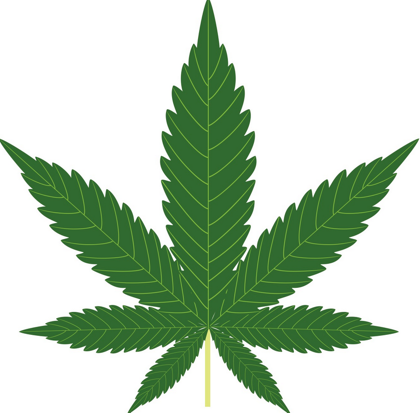Mental Health | Cannabis-Induced Psychosis after ingested Edible

 Mental Health | A 32-year-old woman with a history of iron-deficiency anemia was brought in by ambulance because of altered mental status. The patient's sister and boyfriend reported that 1 day before presentation, the patient had ingested a marijuana edible and a few hours later developed fatigue and nausea, followed by at least 15 episodes of nonbloody, nonbilious, projectile vomiting throughout the night.
Mental Health | A 32-year-old woman with a history of iron-deficiency anemia was brought in by ambulance because of altered mental status. The patient's sister and boyfriend reported that 1 day before presentation, the patient had ingested a marijuana edible and a few hours later developed fatigue and nausea, followed by at least 15 episodes of nonbloody, nonbilious, projectile vomiting throughout the night.
In the morning, she became very pale, her lips turned blue, and she became stiff, losing consciousness for about 10 seconds. Her boyfriend turned her on her side and called 911.
When the patient awoke from this episode, she was combative, confused, and paranoid, speaking incoherently, saying people were out to get her. She became agitated and combative on her way to the emergency department (ED).
Her boyfriend reported that she had no recent travel, trauma, illness, or sick contacts. She had not used recreational drugs before; this was her first experience with a marijuana edible. She was not taking any medications. Her boyfriend denied the presence of other drugs around the house that she may have ingested and reported that the patient had no personal or family history of mental illness.
At presentation, the patient was febrile to 100.4°F. All other vital signs were within normal limits. She was notably disoriented, agitated, and combative and did not answer questions or follow commands. She was normocephalic with no signs of head trauma. Pupils were dilated, symmetric, and reactive to light, and sclera was anicteric. Respiratory, cardiac, and abdominal exam revealed no abnormalities. Extremities were warm and well perfused. The patient was not oriented to person, place, or time. She moved all limbs spontaneously and showed no focal neurologic deficits.
Diagnostic Studies
Laboratory studies were significant for a hemoglobin of 10.4 g/dL. Her sodium level was 121 mmol/L; potassium, 3.0 mmol/L; chloride, 87 mmol/L; bicarbonate, 16 mmol/L; anion gap, 18; glucose, 148 mg/dL; lactate, 3.5 mmol/L; and creatine kinase (CK), 2545 mmol/L, which increased to 43,120 mmol/L.
Urine toxicology was positive for marijuana and negative for benzodiazepines, cocaine, amphetamines, opiates, barbiturates, phencyclidine, and methadone. Serum alcohol level was below detectable limits. Urine K2 (Spice, a synthetic cannabinoid) test was negative.
A CT scan of the head without contrast was negative for any acute abnormality. Blood cultures showed no bacterial growth at 5 days. Cerebrospinal fluid (CSF) was clear with 0 nucleated cells and 1 red blood cell. CSF protein was 25 mg/dL and glucose was 73 mg/dL. A video electroencephalogram showed no seizure activity.
Differential Diagnosis
Because the symptoms started soon after the patient consumed cannabis and the patient displayed paranoia and agitation, the most likely diagnosis is cannabis-induced psychosis. But the differential also includes toxic metabolic encephalopathy from ingestion of an unknown substance or drug besides marijuana, metabolic encephalopathy, and grand-mal seizure with a postictal state caused by hyponatremia after excessive vomiting. Because of the fever, the differential also should include encephalitis, although this is less likely, as the symptoms had a sudden onset, the patient showed no focal neurologic deficits, and CSF showed no nucleated cells.
A Case of Cannabis-Induced Psychosis After Ingested Edible
Initial Management
The patient was given a single dose of vancomycin, ceftriaxone, and dexamethasone for possible meningitis while awaiting the CSF results. She was also given 3 L of normal saline over 10 hours, which corrected her sodium to139 mmol/L over 10 hours. The patient was admitted to medical telemetry and started on intravenous (IV) dextrose 5% for rapid overcorrection of serum sodium and hydration for renal protection in the setting of the elevated CK. She continued to be agitated and was given multiple doses of IV push lorazepam 0.5-1 mg and midazolam 2 mg. She was started on haloperidol 0.5 mg every 4 hours as needed for agitation.
The patient's mental status remained altered for 48 hours. On hospital day 3, she became alert and oriented to person, place, and time, and answered questions appropriately. She did not recall taking or eating anything other than what was previously reported, or recall any events since the initial change in her mental status. She reported that her memory felt "foggy," and she was fatigued. Her serum CK decreased to less than 5000 mmol/L, and IV fluids were discontinued.
The patient soon developed a severe, throbbing, bilateral temporal headache that was exacerbated by movement. This headache persisted for 7 days and was refractory to nonsteroidal anti-inflammatory drugs, Fioricet (acetaminophen, butalbital, and caffeine), and ketorolac tromethamine. MRI of the head with angio- and venogram showed no cerebral venous congestion or other abnormalities. CT angiography of the head was negative for vasculitis. On hospital day 10, the patient's headache improved.
She was advised to avoid marijuana and was discharged to home. She was encouraged to follow up with her primary care physician and a neurologist.
Research Overview
Cannabis has long been associated with symptoms of psychosis, with some of the earliest reports dating as far back as 1845. Since then, the relationship between cannabis use and the presence of psychotic symptoms has been well established in the literature. The presence of paranoia, grandiose delusions, perceptual alterations, and depersonalization/derealization have all been documented; for the vast majority of cases, these symptoms resolve with the resolution of intoxication. Recent studies in genetics have begun to link specific single nucleotide polymorphisms to cannabis-induced changes in cognition, as well as psychotomimetic symptoms.
Cannabis-induced psychosis that outlasts intoxication is much rarer and is not as well documented. Such psychosis presents immediately after cannabis exposure, lasts beyond the period of intoxication, and sometimes requires clinical intervention. In addition to those mentioned above, symptoms include amnesia, emotional lability, confusion, and disorientation.
A case-controlled study found that patients with cannabis-induced psychosis displayed more hypomania and agitation, with less flat affect, auditory hallucinations, incoherent speech, and hysteria when compared with control subjects with "endogenous" psychosis. Another study found that patients with cannabis-induced psychosis were more violent and panicky and demonstrated more bizarre behavior then schizophrenic control patients.
In stark contrast to nondrug-induced psychosis, which tends to last much longer, these studies report that psychotic symptoms typically completely resolve within a few days and do not reoccur. With longer follow-up, however, nearly half of patients who were hospitalized for cannabis-induced psychosis and no previous psychiatric disorder were later diagnosed with a schizophrenia-spectrum disorder, and around three-quarters were diagnosed with any psychiatric disorder.
Recent studies have begun to establish links between single nucleotide polymorphisms at specific gene loci and symptoms of psychosis induced by cannabis use. One such gene is the AKT1 gene, located on chromosome 14q32. This encodes a serine / threonine kinase that participates in a wide variety of functions such as glucose metabolism and cell cycle regulation, as well as neuronal cell size and survival. Delta-9-tetrahydrocannabinol has been shown to activate AKT1 in vivo in the hippocampus as well as the cerebellum, and participates in the striatal dopaminergic signaling cascade.
Two studies have shown that the C allele of the rs2494732 locus of the AKT1 genotype is associated with an increased risk for developing psychosis from cannabis use in patients with a familial risk for schizophrenia. Morgan and colleagues have further shown that the C allele is associated with an increase in cannabis-induced acute psychotomimetic symptoms in young, healthy subjects with no personal or family history of mental illness. This effect was only found while the individual was acutely intoxicated, and to date, no specific gene loci have been found to be associated with cannabis-induced psychosis that outlasts intoxication.
Diagnostic Criteria
The Diagnostic and Statistical Manual of Mental Disorders, Fifth Edition, (DSM-5) lists five criteria for diagnosing substance-induced psychotic disorder. The first is the presence of delusions and/or hallucinations.
These symptoms must develop during or soon after substance intoxication or withdrawal, and the substance must be known to be capable of producing the symptoms. This aspect of the diagnosis can be difficult to obtain, as the patient may be ignorant to or incapable of reporting the substance they consumed. Moreover, urine drug screens are becoming less effective at detecting substances as more and more synthetic psychoactive substances hit the streets. Additional diagnostic criteria include the disturbance not being better explained by a nonsubstance-related psychotic disorder. An independent disorder should be considered if the patient has a personal or family history of nondrug-induced psychosis, or if the symptoms persist for more than 1 month. The disturbance cannot occur exclusively during a period of delirium, and it must cause clinically significant distress or impairment in social, occupational, or other important areas of functioning.
Additional diagnostic criteria include the disturbance not being better explained by a nonsubstance-related psychotic disorder. An independent disorder should be considered if the patient has a personal or family history of nondrug-induced psychosis, or if the symptoms persist for more than 1 month. The disturbance cannot occur exclusively during a period of delirium, and it must cause clinically significant distress or impairment in social, occupational, or other important areas of functioning.
Treatment
The American Psychiatric Association does not currently offer specific guidelines for the treatment of cannabis-induced psychosis. As shown by previous case series and reports, treatment typically requires inpatient monitoring for the duration of the disturbance to ensure the safety of the patient and those around them. If the patient is severely agitated and is a danger to themselves or others during monitoring, symptomatic control can be achieved with benzodiazepines and antipsychotics, with one report demonstrating the efficacy of dexmedetomidine with refractory cases.
Symptoms of cannabis-induced psychosis typically resolve within a few days and require no further treatment. Patients should be encouraged to discontinue cannabis use to prevent the recurrence of symptoms. Nearly all cases reported in the literature occurred in individuals with a history of heavy cannabis use. This suggests that patients may benefit from cessation counseling and continued management to ensure cessation of substance use.
Clinical Pearls
* Cannabis-induced psychosis is a condition characterized by the sudden onset of psychosis after the consumption of marijuana.
* Symptoms can include paranoia, grandiose delusions, perceptual alterations, depersonalization/derealization, amnesia, emotional lability, confusion, agitation, combativeness, and disorientation.
* Patients may require hospitalization; symptoms can be managed with benzodiazepines and antipsychotics.
* Symptoms typically resolve as intoxication resolves, but in rare cases, they may persist for many days.
* Patients typically return to their baseline mental status after symptomatic resolution.
* The C allele of the rs2494732 locus of the AKT1 gene has been found to be associated with an increased risk for developing symptoms of psychosis after consumption of marijuana in both young, healthy patients and those with a personal or family history of mental illness.
* Patients who experience marijuana-induced psychosis have a nearly 50% chance of developing a schizophrenia spectrum disorder, and nearly 75% chance of developing any psychiatric disorder within the next 8 years.
* Patients may benefit from close follow-up and monitoring for symptoms of mental illness to ensure proper treatment.
Source:


